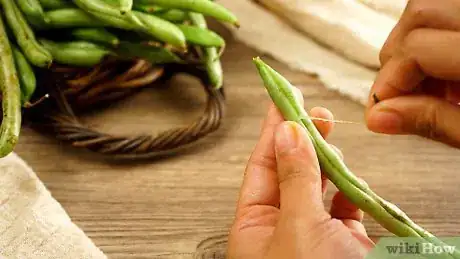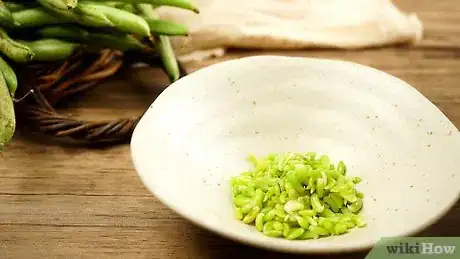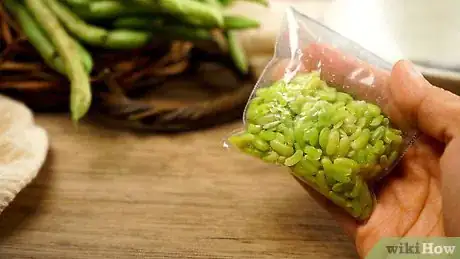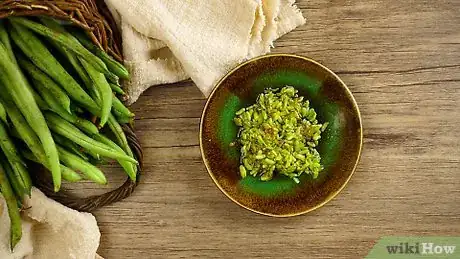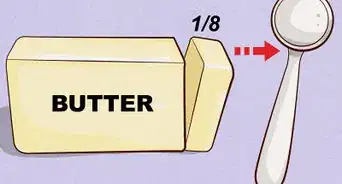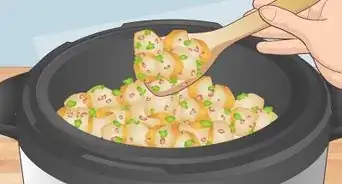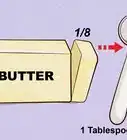This article was co-authored by wikiHow staff writer, Janice Tieperman. Janice is a professional and creative writer who has worked at wikiHow since 2019. With both a B.A. and M.A. in English from East Stroudsburg University, she has a passion for writing a wide variety of content for anyone and everyone. In her free time, you can find her working on a new crochet pattern, listening to true crime podcasts, or tackling a new creative writing project.
There are 13 references cited in this article, which can be found at the bottom of the page.
The wikiHow Culinary Team also followed the article's instructions and verified that they work.
This article has been viewed 16,922 times.
Learn more...
Fava beans are tasty on their own, or they can be used as a garnish or side for other delicious dishes. Typically, the beans are removed from the shell before being blanched, or boiled, which makes them much easier to enjoy. When it comes to fava beans, the sky’s the limit—you can cook blanched beans, or enjoy fava beans while they’re still in the pod. You also have the option of working with dried beans, which are a great ingredient for savory dishes. Play around with the ingredients you have on hand and see what you can come up with!
Ingredients
Sautéed Fava Beans
- 2 lb (0.91 kg) of fava beans
- 1 US tbsp (15 mL) of butter
- 1 tsp (4.9 mL) of olive oil
- 2 garlic cloves, minced
- Salt and pepper, as a garnish
Grilled Fava Bean Pods
- 1 lb (0.45 kg) of fava beans, in the pod
- 2 US tbsp (30 mL) of extra-virgin olive oil
- 1 scallion, sliced crosswise
- ½ tsp (0.9 g) of crushed red pepper
- Salt
- Lemon wedges, as a garnish
Dried Fava Bean Stew
- 1⁄2 lb (0.23 kg) of fava beans, dried and shelled
- 1⁄2 c (120 mL) of extra-virgin olive oil
- 1 lb (0.45 kg) of bitter greens
- Salt and pepper
Steps
Prepping and Blanching Raw Beans
-
1Pull and peel the top to “unzip” the pod. Look along the top of the fava bean pod to find a narrow, pointy section. Grab this section and pull it down, as though you’re unzippering a jacket. As you open the pod, you’ll see a string coming off the center.[1]
- It may help to slide your finger down the pod so it opens all the way.[2]
- Typically, 1 lb (0.45 kg) of fava beans equals about 1 cup (170 g) of fava beans. Keep this in mind if you’re following a recipe!
-
2Take all the beans out of the pod. Gently pluck and set aside all the beans from inside the pod. Typically, fava bean pods tend to have 4-5 individual beans inside, which you can set aside in a separate bowl or container.[3]Advertisement
-
3
-
4Fill a separate bowl with ice water. Before you actually start blanching the fava beans, fill a separate bowl with cool water, along with a handful ice cubes. Double-check that the bowl is big enough to hold all the beans you plan on cooking![6]
- The ice water will help put a stop to the cooking process.
-
5Boil the fava beans for 1 minute to cook them. Place the pot over high heat and wait for it to reach a boil. Once the water is visibly boiling, pour the individual beans into the hot water. Set a timer for 1 minute, so you don’t lose track of time.[7]
- Some people find that 30 seconds is enough to blanche their beans. It’s up to you![8]
- Be careful not to burn yourself from steam and boiling water. Slowly pour the beans into the pot so the water won’t splash you accidentally. It may also help to use a pair of tongs.
-
6Transfer the cooked beans to the ice water so they cool off. Turn off the heat and drain the leftover water out of the pot. Once the hot water is gone, pour the hot beans into the prepared bowl of ice water. At this point, wait a few minutes for the beans to cool down completely.[9]
- Your beans should look green as they cool.
-
7Squeeze each bean and open it with your nail. Hold a bean between your thumb and pointer finger and give it a good squeeze to apply some pressure to the skin. Pierce the skin with your thumbnail to free the bean from its waxy outer skin.[10]
- You may notice that the skin comes off on its own in the ice water.[11]
-
8Serve the beans if you’re planning on eating them right away. Transfer the peeled beans to a bowl or serving dish if you’re planning on eating them plain, or using them in another recipe. Now that both the pod and skin are removed, your fava beans are ready to enjoy![12]
-
9Store the cooked beans in the refrigerator or freezer. You can keep cooked fava beans in the refrigerator for up to a week by transferring them into a sealable plastic bag, then push out all the extra air. If you don’t want to eat the beans immediately, move the beans to sturdy, freezer-safe container, which will keep them fresh for a few months.[13]
- It may help to label the bag so you remember when you cooked them.
- The freezer will keep your beans green, even if you don’t enjoy them immediately.
Sauteeing the Beans
-
1Heat up a skillet with garlic, oil, and butter for 1 minute. Pour 1 US tbsp (15 mL) of butter, 1 tsp (4.9 mL) of olive oil, and 2 minced garlic cloves into a large pan. Mix these ingredients together over medium heat, letting the garlic sautee in the mixture.[14]
-
2Cook and transfer the fava beans into the garlic mixture. Peel and blanche 1½ to 2 cups of fava beans and boil up to 3 minutes so they’re soft and easier to cook with. Once you’ve boiled the fava beans, cool them off in ice water so they’re no longer cooking. At this point, you can pour the cooked beans into the garlic mixture in the skillet.[15]
- You can also frozen, pre-blanched beans for this.
-
3Let the beans cook for 5 minutes. Set a timer for 5 minutes, stirring the beans in the hot oil and butter mixture as you wait. Once the timer is up, remove the beans from the skillet so they’re ready to serve.[16]
- If your beans don’t look sautéed after 5 minutes, leave them in for another 2 minutes.
-
4
Grilling Whole Pods
-
1Mix the fava beans in a bowl with 2 US tbsp (30 mL) of olive oil. Pour 1 lb (0.45 kg) of rinse fava beans into a large bowl. Mix in 2 US tbsp (30 mL) of olive oil, so they’ll be ready to toss on the grill.[19]
- If you don’t have a grill, you can roast your fava bean pods in the oven for 10 minutes at 425 °F (218 °C).[20]
-
2Set your grill to a high heat setting. Whether you have a gas or charcoal grill, you’ll want the grill top to be very hot once you start cooking. Set a custom temperature if you’re using a gas grill, or continue monitoring your charcoal grill until it’s extremely hot.[21]
-
3Spread your oil-coated fava beans over the grill. Use tongs or a separate utensil to place the fava beans on the grill top. Try to separate them so none of the pods are overlapping, which will help them cook evenly.[22]
- You can always cook the beans in shifts, if you need to.
-
4Flip the beans until they’re a bit charred on some parts of the pod. Leave the beans on the grill for several minutes, using a grill spatula or other utensil to flip the pods over once in a while. Check for charred spots on the surface of the pods, which means that they’re ready to remove from the grill.[23]
-
5Remove the pods and mix them with red pepper, chopped scallion, and salt. Transfer the grilled pods into a large bowl, adding in a chopped scallion and ½ tsp (0.9 g) of crushed red pepper for garnish, along with a pinch of salt. Move the seasoned pods on to a plate, along with some lemon wedges for garnish.[24]
- You can also use Chinese chile sauce instead of crushed red pepper, if needed.
Boiling Dried Beans
-
1Refrigerate the soaking beans overnight and remove the outer skin. Add 1⁄2 lb (0.23 kg) of dried and shelled fava beans into a large bowl, so they’ll be ready for soaking. Pour water over the dried beans, leaving 3 in (7.6 cm) of water on top. Move the beans into the refrigerator and let them soak overnight, or for at least 8 hours.[25] Once the beans have had ample time to soak, peel off the outer skin from each bean.[26]
- This process may be a bit time consuming, but it’ll make it easier to prepare your dish.
-
2Transfer the peeled fava beans to a pot and cover them with water. Set a large, sturdy pot on your stovetop and add in the peeled fava beans. After you’ve done this, pour enough cold water into the pot to cover the beans completely, which will help with the cooking process.[27]
-
3Turn on the stovetop and wait for the beans to boil. Set the burner to a high temperature and put a lid on the pot, so the water and beans will boil more efficiently. Check on the beans periodically to see if they’re boiling, which means you’re ready to continue on with the recipe.[28]
- As the water starts boiling, it may help to scoop out the foam with a slotted spoon.
-
4Salt and cook the beans for 1 hour. Stir a pinch of salt into the pot, then set a time for 1 hour to let the peeled beans boil and cook thoroughly. Throughout this hour, stir the beans often to keep the mixture consistent. If too much water evaporates, pour in more cold water so your beans are completely covered as they cook.[29]
-
5Mash the beans in the last 10 minutes of boiling. Wait until there’s about 10 minutes left on your cooking timer, then grab a wooden spoon. Keep stirring the beans, using the spoon to mash them into a thick, clotted cream-like consistency.[30]
- The texture of the mashed beans doesn’t have to be super consistent.
-
6Stir in 1 c (240 mL) of olive oil and other seasonings. Pour in some olive oil, along with a pinch of salt and pepper for flavor. Mix these ingredients into the beans to help give your dish the consistency and taste that you’re looking for.[31]
-
7Cook 1 lb (0.45 kg) of bitter greens in boiling water. Grab your greens of choice, whether their dandelion greens, bitter greens, broccoli rabe, or watercress. Rinse off your greens before adding them into a separate pot of boiling water. Wait several minutes for the greens to cook, or until they’re soft and tender.[32]
-
8Drain and season the greens and serve them the beans. Transfer the greens to a colander, letting all the leftover water drip out. Mix the green with another 1 c (240 mL) of olive oil, along with a pinch of salt and pepper. Place a scoop of greens on a plate, along with a scoop of your cooked fava beans.[33]
- Thick bread is a great side with this dish.
Community Q&A
-
QuestionIf I choose to oven-roast some fava beans from a can (instead of fresh or frozen), will your recipe need to be altered/adjusted in any way?
 Hélène FuchsCommunity AnswerCanned fava beans are usually already cooked, while fresh or frozen fava beans are raw. Just adjust cooking time so they won't turn to mush. No other changes are necessary.
Hélène FuchsCommunity AnswerCanned fava beans are usually already cooked, while fresh or frozen fava beans are raw. Just adjust cooking time so they won't turn to mush. No other changes are necessary.
Warnings
- If you take monoamine oxidase inhibitor medication, which is a type of antidepressant, check with your doctor before consuming fava beans. The beans can cause serious symptoms, like spikes in blood pressure, if you take this medicine.[36]⧼thumbs_response⧽
- If you have a G6PD deficiency, or favism, eating fava beans can cause severe anemia.[37]⧼thumbs_response⧽
Things You’ll Need
Prepping Raw Beans
- Saucepan
- Hot water
- Bowl
- Ice water
- Airtight container (optional)
- Plastic bag (optional)
Sauteeing the Beans
- Skillet
Grilling Whole Pods
- Grill
- Grill spatula
- Bowl
Boiling Dried Beans
- Water
- Large cooking pot
- Saucepan or pot
- Colander
- Slotted spoon
- Wooden spoon
References
- ↑ https://www.thekitchn.com/how-to-pick-clean-and-prepare-84710
- ↑ https://www.epicurious.com/ingredients/how-to-prepare-fava-beans-gallery
- ↑ https://www.thekitchn.com/how-to-pick-clean-and-prepare-84710
- ↑ https://www.epicurious.com/ingredients/how-to-prepare-fava-beans-gallery
- ↑ https://www.food.com/recipe/gabriel-s-sauteed-fava-beans-117520
- ↑ https://www.food.com/recipe/gabriel-s-sauteed-fava-beans-117520
- ↑ https://www.epicurious.com/ingredients/how-to-prepare-fava-beans-gallery
- ↑ https://www.thekitchn.com/how-to-pick-clean-and-prepare-84710
- ↑ https://www.epicurious.com/ingredients/how-to-prepare-fava-beans-gallery
- ↑ https://www.epicurious.com/ingredients/how-to-prepare-fava-beans-gallery
- ↑ https://www.thekitchn.com/how-to-pick-clean-and-prepare-84710
- ↑ https://www.epicurious.com/ingredients/how-to-prepare-fava-beans-gallery
- ↑ https://www.epicurious.com/ingredients/how-to-prepare-fava-beans-gallery
- ↑ https://www.food.com/recipe/gabriel-s-sauteed-fava-beans-117520
- ↑ https://www.food.com/recipe/gabriel-s-sauteed-fava-beans-117520
- ↑ https://www.food.com/recipe/gabriel-s-sauteed-fava-beans-117520
- ↑ https://www.food.com/recipe/gabriel-s-sauteed-fava-beans-117520
- ↑ https://www.stilltasty.com/fooditems/index/17167
- ↑ https://www.foodandwine.com/recipes/grilled-fava-bean-pods-chile-and-lemon
- ↑ https://recipes.oregonlive.com/recipes/whole-roasted-fava-beans-with-maitakes-and-ricotta
- ↑ https://www.foodandwine.com/recipes/grilled-fava-bean-pods-chile-and-lemon
- ↑ https://www.allrecipes.com/recipe/257989/grilled-fava-beans/
- ↑ https://www.allrecipes.com/recipe/257989/grilled-fava-beans/
- ↑ https://www.foodandwine.com/recipes/grilled-fava-bean-pods-chile-and-lemon
- ↑ https://www.saveur.com/article/Recipes/Fava-Bean-Stew-with-Garlic-Thyme-and-Bay-Leaves/
- ↑ https://cooking.nytimes.com/recipes/7226-dried-fava-beans-with-bitter-greens
- ↑ https://cooking.nytimes.com/recipes/7226-dried-fava-beans-with-bitter-greens
- ↑ https://cooking.nytimes.com/recipes/7226-dried-fava-beans-with-bitter-greens
- ↑ https://cooking.nytimes.com/recipes/7226-dried-fava-beans-with-bitter-greens
- ↑ https://cooking.nytimes.com/recipes/7226-dried-fava-beans-with-bitter-greens
- ↑ https://cooking.nytimes.com/recipes/7226-dried-fava-beans-with-bitter-greens
- ↑ https://cooking.nytimes.com/recipes/7226-dried-fava-beans-with-bitter-greens
- ↑ https://cooking.nytimes.com/recipes/7226-dried-fava-beans-with-bitter-greens
- ↑ https://www.thekitchn.com/how-to-pick-clean-and-prepare-84710
- ↑ https://www.thekitchn.com/how-to-pick-clean-and-prepare-84710
- ↑ https://www.scienzavegetariana.it/nutrizione/favabeans.html
- ↑ https://www.scienzavegetariana.it/nutrizione/favabeans.html
About This Article
To cook fava beans, start by adding 1 pound of fresh fava beans to a small pan of boiling water. After 30 seconds, or when the skin starts to shrivel, remove the fava beans and put them in a bowl of ice water. Next, drain the beans and remove their outer coatings. Then, sautee 1 minced garlic clove and 2 teaspoons of butter in a skillet on medium heat. After 60 seconds add the fava beans and continue cooking for 5-7 minutes, or until the beans are tender. To learn how to make roasted fava beans, scroll down!
